As highlighted by a recent report by the Argentine Budget Association (ASAP), the expenditure budget of the National Administration presents a “high proportion” of expenditures related to the GPS as a consequence, mainly, of the incidence of social security benefits linked to retirements and pensions in charge of the ANSeS.
The bill presented on September 16 includes authorizations for current and capital expenditures for a total of $ 13,336,520 million, which implies an increase in the 36,9% with respect to the closing forecast of the current Budget.
Budget 2022 Social Spending.jpg
ASAP
In budgetary relevance it is followed by Economic services with 15.5% of the total expenditure and with 8.3% the planned outlays for of interests and commissions of the Public Debt. More relegated is the expenditure identified as Defense and security services (4.2%) and that of the Government administration (5,5%).
Within the universe of expenses included for social spending, 67.6% are concentrated in Social Security, reaching an amount of $ 6,001,366 million. Of this total allocated to Social Security, 67.5% corresponds to allocations to the Integrated retirement and pension system (SIPA), and 12.2% at Family Allowances and the Universal Child Allowance (AUH).
Likewise, other relevant concepts are included in this item, such as Transfers and Contributions to Social Security (3.6%), Non-contributory pensions (2.4%) and Unemployment insurance (0.3%), among others, that make up the aforementioned 67.6% of the total of the GPS (equivalent to 45% of the total spending of the APN).
Other relevant actions within total social spending are those of the Education Development Superior with a 4.2% relative share, the Non-Contributory Pensions for Labor Disability with 3.5%, food policies with 3.3%, the Empower Work Program with 2.7% and those of Prevention and Control of Communicable and Immunopreventable Diseases with 1.9%, among others.
Budget 2022 Expenses by Purpose and Function.jpg

ASAP
The ASAP detected that in 2022 the budget would show a growth of 36.9%, while social spending would increase by 38.9%, so that the participation of the GPS within the total of the APN would experience an increase of 0 in 2022 , 97 percentage points with respect to the projections of the end of 2021.
“This increase is mainly explained by the relative loss of Economic Services for which an interannual growth of 20.6% is expected, 16.3 percentage points less than the general increase in expenses”, emphasized the experts of the Association.
From the comparison of assignments for Social services included in the 2022 bill and the planned closing of 2021, it appears that the lowest growth is observed in the health and work allowances, with year-on-year increases of 12.5% and 9.2% respectively. The remaining functions grew above the average growth of the GPS (38.1%), with a maximum of 86.7% in the case of drinking water and sewerage.
In the case of capital expenditures, they represent 10.8% in the project for 2022 and considering only the GPS, the allocation is reduced to 7.9% of the total.
In the plan for next year, total capital spending would grow in 2022 by 50.4% compared to the current credit in 2021, and by 61.8% if the 2021 closing projections are taken. In the GPS, growth of capital expenditure for 2022, in relation to the current credit as of 09-15-21, rises to 65.9%.
Within the GPS, in the growth of capital expenditures with respect to the current budget, the increases to Science and technology of 115.7%, Education and culture of 88.8%, Promotion and social assistance of 89.4%, Drinking water and sewerage of 75.7%, Housing and urban planning 55.9% and Social Security 35.8%, while decreases of 32.2% and 40.2% were observed in Health and Work, respectively.
In the historical comparison, the 2022 Budget maintains high levels of social spending. In the period 2017 to 2020, the participation of the GPS within the spending of the APN averaged the 63,7%, with 2019 being the one with the lowest participation with 59.39% and 2020 the one with the highest participation with the 67,3%, with the ongoing pandemic.
Expenses associated with Covid-19
Precisely the pandemic declared in March 2020 forced to modify items that year and 2021, as part of the health strategy to control the epidemiological situation.
According to data from the message that accompanies the 2022 Budget Law Project, The Covid-19 pandemic led to a downturn in the economy during the second quarter of 2020 of the order of 25.7%, caused by the macroeconomic crisis that the country was going through, to which were added trade and circulation restrictions by which only certain essential segments related to health, the food industry, substances and chemical products were able to maintain their levels of activity, and even increase them, during confinement.
vaccination minors 3.jpg

Telam
ASAP recalled that through various regulations, the national State sought in the first instance to strengthen the health system, and implemented other measures aimed mainly at alleviating the difficult socioeconomic situation of the population. The fiscal impact of the set of measures adopted, linked to the COVID-19 package, was, in 2020, around 6.5% of GDP.
According to official information, for 2021 an expense associated with Covid-19 is projected in the order of $ 725,000 million for the entire APN, 1.7% of GDP, earmarked for the purchase of vaccines, strengthening the health system and sustaining income, production and employment. As for what is strictly associated with the GPS, according to this message, the COVID expenditure of closing 2021 would contain about $ 335,207.4 million, that is to say 5.2% of the total of the GPS 2021.
By 2022, The bill that awaits approval in Congress does not discriminate the estimate of expenses directly linked to the Covid-19 event.
Budget 2022: more funds for ANSES
By 2022, credit allocations have been included for ANSES for $ 5,482,708 million, which in their entirety are used for the purpose of Social Services, which is equivalent to 41.1% of the total budget of the APN and 61.8% of the GPS. Such percentages maintain proportionality in relation to the budget as of 09-15-21, in which they reach 40.5% and 61.7% respectively.
The allocations foreseen for 2022 contemplate a global increase of 42.1% with respect to the 2021 Current Budget, highlighting the year-on-year increase of 51.1% for the universal allocation for social protection.
Source From: Ambito
David William is a talented author who has made a name for himself in the world of writing. He is a professional author who writes on a wide range of topics, from general interest to opinion news. David is currently working as a writer at 24 hours worlds where he brings his unique perspective and in-depth research to his articles, making them both informative and engaging.




